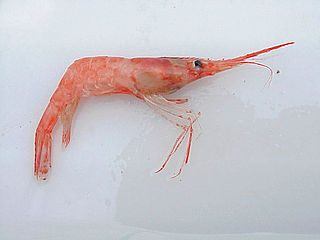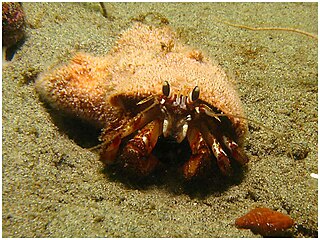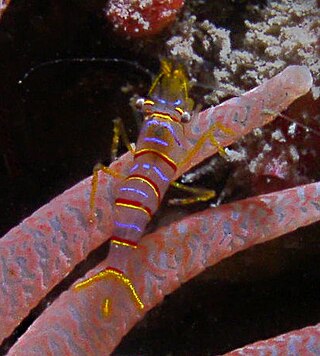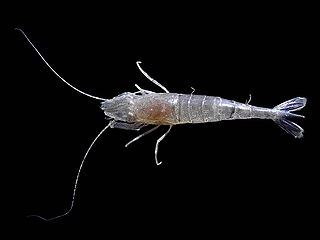
The Caridea, commonly known as caridean shrimp or true shrimp, from the Greek word καρίς, καρίδος, are an infraorder of shrimp within the order Decapoda. This infraorder contains all species of true shrimp. They are found widely around the world in both fresh and salt water. Many other animals with similar names – such as the mud shrimp of Axiidea and the boxer shrimp of Stenopodidea – are not true shrimp, but many have evolved features similar to true shrimp.

Pandalus borealis is a species of caridean shrimp found in cold parts of the northern Atlantic and northern Pacific Oceans, although the latter population now often is regarded as a separate species, P. eous. The Food and Agriculture Organization refers to them as the northern prawn. Other common names include pink shrimp, deepwater prawn, deep-sea prawn, Nordic shrimp, great northern prawn, northern shrimp, coldwater prawn and Maine shrimp.

The shrimp fishery is a major global industry, with more than 3.4 million tons caught per year, chiefly in Asia. Rates of bycatch are unusually high for shrimp fishing, with the capture of sea turtles being especially contentious.

The family Pandalidae is a taxon of caridean shrimp. These species are commonly called pandalid shrimp. They are edible and have high economic value. They are characterised by the subdivided carpus of the second pereiopod and, mainly, by the lack of the chelae (claws) on the first pereiopod. This is a cold-water family, and their representation in tropical areas is made by deep-sea shrimp. The genus Physetocaris, sometimes placed in this family, is now considered to be in its own family, Physetocarididae.

Athanas is a genus of shrimp of the family Alpheidae. These are small shrimp measuring 2 cm in length. Females have smaller chelae than males.

Betaeus is a genus of shrimp in the family Alpheidae, containing the following species:

Majidae is a family of crabs, comprising around 200 marine species inside 52 genera, with a carapace that is longer than it is broad, and which forms a point at the front. The legs can be very long in some species, leading to the name "spider crab". The exoskeleton is covered with bristles to which the crab attaches algae and other items to act as camouflage.

Pagurus is a genus of hermit crabs in the family Paguridae. Like other hermit crabs, their abdomen is not calcified and they use snail shells as protection. These marine decapod crustaceans are omnivorous, but mostly prey on small animals and scavenge carrion. Trigonocheirus and Pagurixus used to be considered subgenera of Pagurus, but the former is nowadays included in Orthopagurus, while the latter has been separated as a distinct genus.

Hippolyte is a genus of shrimp in the family Hippolytidae, containing the following species:

Palaemon is a genus of caridean shrimp in the family Palaemonidae.

Pandalus platyceros, also called California spot prawn or Alaskan prawn, is a shrimp of the genus Pandalus.
Pink shrimp may refer to any of the following species:

Lebbeus is a genus of shrimp in the family Thoridae. It includes a species whose name was auctioned in 2009 to raise funds for conservation; Luc Longley won with a bid of A$3,600. He named the shrimp Lebbeus clarehannah. The following species are included:

Lysmata is a genus of shrimp in the infraorder Caridea, the caridean shrimp. The genus belongs to the family Lysmatidae. Lysmata are popular ornamental shrimp in the marine aquarium trade for their bright color patterns, interesting behaviors, and ability to control certain aquarium pests such as sea anemones of the genus Aiptasia. They are known to command high prices on the pet market.

Pandalus montagui is a species of cold-water shrimp in the family Pandalidae. It is the type species of the genus Pandalus and is variously known as the pink shrimp, Aesop shrimp and Aesop prawn.

Sicyonia is a genus of prawns, placed in its own family, Sicyoniidae. It differs from other prawns in that the last three pairs of its pleopods are uniramous, rather than biramous as seen in all other prawns.

Pilumnus is a genus of crabs, containing the following species:

Crangon is a genus of shrimp.

Pandalus hypsinotus is a crustacean in the Pandalidae family, ordinarily 10–12.5 centimetres (3.9–4.9 in) in length, but large females may reach 17.5 centimetres (6.9 in). It can be found in the Bering Sea, from the Aleutian Islands to Puget Sound, and in the Sea of Japan at depths of 100–200 metres (330–660 ft).

Heptacarpus is a genus of shrimps in the family Thoridae. There are more than 30 described species in the genus Heptacarpus.




















